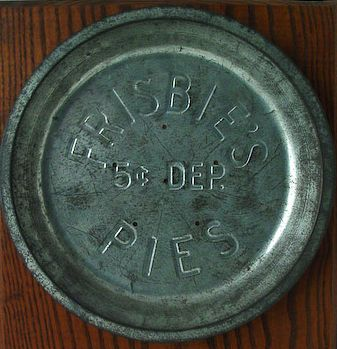College students are the origin of what is now known as a Frisbee. In Bridgeport, Connecticut back in the early 1900's there was a business by the name of
the Frisbie Baking Company. This company used pie pans that resemble a modern day Frisbee. Unbeknownst to the company, college students would throw
these pie pans (below) back and forth because they would glide though the air and served as great entertainment. So, the word Frisbee comes from the company
Frisbie.

http://www.toysperiod.com/images/frisbies-pies-original-frisbee.png
Walter Frederick Morrison with his business partner Warren Franscioni, realized the selling potential for such a great product and began to produce a Frisbie
that was made of plastic. This plastic Frisbie was lighter, more accurate, and flew further than the pie pan of Frisbie Baking Company. Four years after splitting
with his business partner in 1950, Morrison created his own company and created the 'Pluto Platter'(below). During this time the United States public was excited
about the prospect of UFO's and flying saucers, so the name of the new Frisbie was a good selling point. The characteristic rim of the Frisbie is called the
Morrison Slope and is on the original patent.

http://ffden-2.phys.uaf.edu/211_fall2010.web.dir/M_Allard/Photos/PlutoPlatter.jpg
The owners of Wham-O, rich Knerr and A.K. Melin purchased the rights to Morrison's invention for $1 million.
One of the first things the new owners did was change the name from Frisbie to Frisbee. Wham-O's general manager, Edward Headrick hired in 1964,
put the marketing of the Frisbee on the fast track. He made changes to the design of the 'Pluto Platter', including the rim, and top design. This made the product
even more stable and accurate. Edward Headrick is now recognized at 'The Father of Disc Sports', creating the International Frisbee Association and many games.

http://i1.wp.com/discgolf.com/wp-content/uploads/2012/05/historyofdiscgolf640.jpg